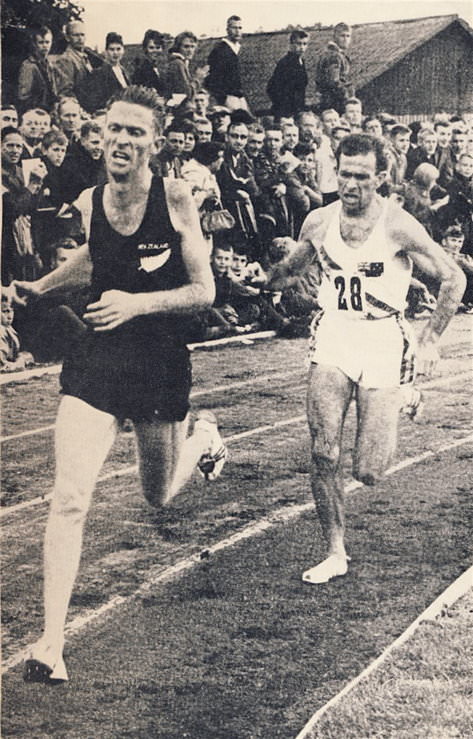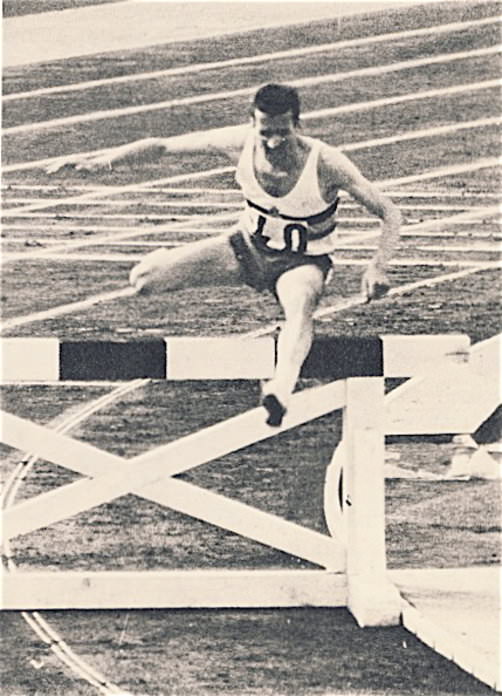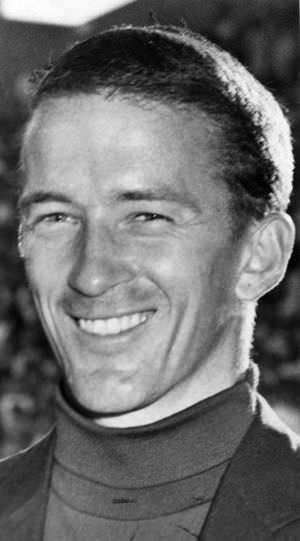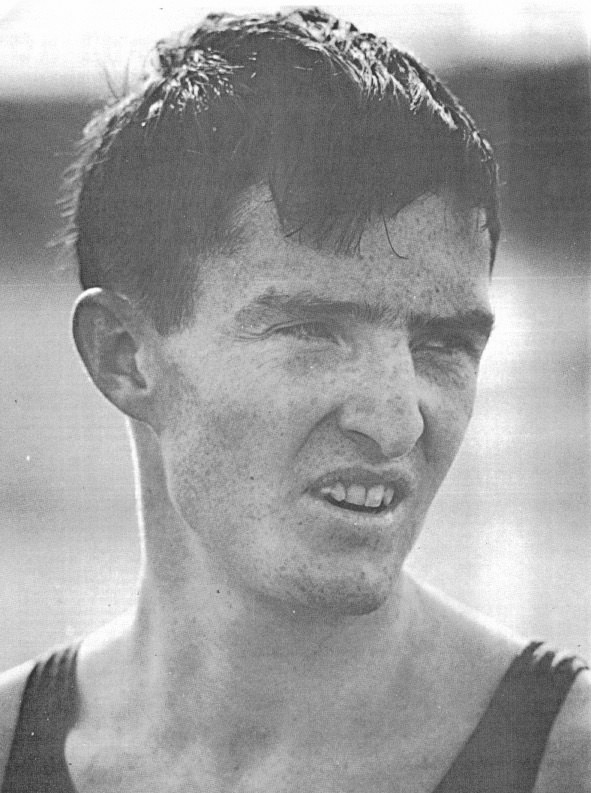Bodo Tümmler Profileb. December 8, 1943 In 1965 West German Bodo Tümmler burst dramatically on to the 1,500 European scene that had been dominated by Michel Jazy, Siegfried Valentin and Witold Baran. His European Cup victory and his fast 3:39.5 clocking at the age of 21 promised great things. The next year he won the European 1,500 title from 30-year-old Michel Jazy and placed a close third in the 800. Demonstrating not only great tactical skills but also strength and speed, the Berliner was being hailed as Europe’s Peter Snell. And although he was slowed somewhat by injuries the next year, his 1968 pre-Olympic form was impressive. And he did well in the high altitude of Mexico City, coming third in the 1,500 behind two great performers in Keino and Ryun. Sadly his career deteriorated after this as he battled with injuries. He never quite regained the form of his glory years between 1965 and 1968. But in those few years he was among the best in the world.
Bolotnikov v Tulloh v Zimny5,000 European Championships 1962Great Races #15 Following his convincing 10,000 win, Russian Pyotr Bolotnikov (See Profile) looked a good bet for this race too. But his heat for this final was held only 24 hours after his 10,000 final. Further, he was forced to run a fast 13:53.4 to qualify (10th fastest time in the 1962 world rankings), so the recovery powers of this 32-year-old Russian were sure to be tested. The two other heats were won in the slow times of 14:14 and 14:15. Janke, who had run so well in the 10,000 was still tired and could manage only 8th in his heat. Prominent among the qualifiers were Zimny and Boguszewicz of Poland and Frenchmen Bogey and Bernard. Englishman Tulloh thought he had a chance. He had run a four-minute Mile and an 8:33.4 Two Miles in January, which meant he had the best basic speed in the field, but he had recently been beaten by Zimny.
Bruce Tulloh Profile 1935-20185’7”/1.71; 119lbs/54kg Bruce Tulloh became a world-class runner in the 1960s, despite having limited natural talent. When in 1955 he returned home to England from his military service in Hong Kong, he was little more than an also-ran, someone endearingly called a scrubber in British running clubs. As a 20-year-old he had barely beaten 16:00 for Three Miles (16:30 for 5,000), and his only claim to fame was a Hong Kong Three Miles title. True, he did really enjoy running, but there was no indication that within four years he would be the British Three Miles Champion and that within seven years the European 5,000 champion.

Dave Power: Profile1928-2014One of the greatest Australian runners between 1958 and 1962, Dave Power was overshadowed by the world records and gold medals of Herb Elliott and Murray Halberg. Power never set a world record, but his competitive record in major games has rarely been matched: two gold medals in the 1958 Commonwealth Games, a bronze and a fifth place in the 1960 Olympics and two silver medals in the 1962 Commonwealth Games. It is worth noting that he achieved all this in his thirties. For Power, the road to the top was a long one; he competed in his first national championships back in 1950-1. When many would have abandoned the rigorous training he undertook, Power’s joy of running and appetite for success kept him going. His tenacity and courage were admired by many of his peers.
Elliott v Jazy v Rozsavolgyi1,500, Olympic Games 1960, RomeGreat Races # 13 This race had a clear favorite: Australian Herb Elliott. His stunning Mile and 1,500 WRs in 1958 had shocked the world. The only concern was his lack of top-class competition immediately before the Games. Still, there were some other good runners in the field. Dan Waern of Sweden and Rozsavolgyi of Hungary were the pick from Europe. And France had two promising finalists in Michel Bernard and Michel Jazy. Two other potential medalists, Merv Lincoln of Australia and Siegfried Valentin of East Germany, were eliminated in the heats.

b. February 5, 1937 1.74/5’8 67kg/147lbs Very few runners have achieved as much success as Gaston Roelants. For 15 years, from 1960 (4th in the Olympics) to 1974 (3rd in the Europeans), this Belgian athlete was at the very top of his sport. And amazingly he excelled in five different areas of running: he was the 1964 Olympic gold medalist and WR holder in the steeplechase; he was a four-time winner of the International Cross-Country Championships; he was European silver and bronze medalist in the Marathon; he ranked consistently high in world rankings for the 5,000 (twice in the top six) and 10,000 (five times in the top six); and finally he set four WRs for long-distance track races (One Hour and 20K).

American middle-distance runner George Young will be remembered most of all for establishing American steeplechasing on the international map, for solidifying the 1952 gold-medal achievement of Horace Ashenfelter. Young placed fifth and third in the 1964 and 1968 Olympic Steeplechase finals and set an American record of 8:30.4. He will also be remembered for his competitive toughness. This toughness was perfectly exemplified near the end of his career (at age 36) when he had an memorable battle with 21-year-old Prefontaine in the 1972 USA Olympic Trials 5,000. Young’s ongoing reputation as a tough guy was brilliantly captured in the Prefontaine movie Without Limits. In a memorable scene (http://cdn1.anyclip.com/BTCO2tntJhYbu.mp4), Donald Sutherland, playing Coach Bill Bowerman, visits Prefontaine (Billy Crudup) to announce with great gravity: “George Young is in town.” This echoes a classic line in many western movies when locals learn that a famous gunfighter has arrived in town. George Young was indeed a “famous gunfighter” on the American track scene in the 1960s and early 1970s.

Few runners have appeared on the distance-running scene as dramatically as American Gerry Lindgren. In 1964 while still a schoolboy, he emerged from a remote area of Washington State near the Canadian border to run a series of world-class races. His successes that year took him to the Tokyo Olympics as one of the favorites in the 10,000. Until the 1960s teenagers rarely competed in distance events. It was universally believed that distance running was a mature man’s sport; teenagers were strongly discouraged from running long distances on the road and track. Only in cross-country races were they allowed to run longer distances up to 5,000.
Halberg v Grodotzki v Zimny1960 Olympic Games 5,000 RomeGreat Races #14 If Elliott’s victory in the 1,500 was the most dominant track performance of the Rome Olympics, Murray Halberg’s was the most courageous. To inject a 61.1 tenth lap in a 5,000 meant that he had exposed himself completely. He had planned with his coach Arthur Lydiard to carry out this daring strategy: “Towards the end of the race he would launch himself into a breakneck speed for a whole lap. He would hold this speed for as long as possible. It would gradually and inevitably fade until he and the whole field were drained of all their speed. They would then have to run the last lap in a state of utter exhaustion, on rubber legs, gasping for breath.” (Norman Harris, Lap of Honour, p. 111) Although certainly not the most talented runner in the field, Halberg was the most determined to win. And he did.
Profile: Harald Norpoth b. 1942 BeginningsBetween 1964 and 1973, Harald Norpoth was a dominant force in international middle-distance running. Combining stamina with a punishing finishing kick, he won more than three-quarters of his outdoor track races. Although he never won a major championship, he was universally respected as a 1,500/5,000 runner. A three-time Olympian, his best performance was 2nd in the Tokyo 5,000 in 1964. However, he also ran extremely well in the Mexico 1,500 (fourth) and the Munich 5,000 (sixth). On the European scene, he won gold medals in three consecutive European Cups and in the European Championships he won one silver and two bronze medals. Although more of a racer than a record-beater-- "I was more the competitive type”--he did set a WR for 2,000 (4:57.8) and European records for 5,000 (13:24.8) and 3,000 (7:45.2). Norpoth once received a telling compliment from another great competitor of his era, Ian Stewart: “I respect him even more than Ron Clarke. Some think Clarke’s the be all and end all of running. He’s bloody good. But as a racer I’ve got to go for someone like Norpoth.” (The Times, Oct 24, 1969)